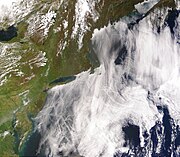More than 100 years ago, people around the world started burning
large amounts of coal, oil, and natural gas to power their homes,
factories, and vehicles. Today, most of the world relies on these fossil
fuels for their energy needs. Burning fossil fuels releases carbon
dioxide, a heat-trapping gas, into the atmosphere, which is the main
reason why the climate is changing.
Heat-trapping gases are also called greenhouse gases. They exist naturally in the atmosphere, where they help keep the Earth warm enough for plants and animals to live. But people are adding extra greenhouse gases to the atmosphere. These extra gases are causing the Earth to get warmer, setting off all sorts of other changes around the world—on land, in the oceans, and in the atmosphere. And these changes affect people, plants, and animals in many ways.
Learn more about carbon dioxide and other greenhouse gases and how they are changing the Earth's climate:
Heat-trapping gases are also called greenhouse gases. They exist naturally in the atmosphere, where they help keep the Earth warm enough for plants and animals to live. But people are adding extra greenhouse gases to the atmosphere. These extra gases are causing the Earth to get warmer, setting off all sorts of other changes around the world—on land, in the oceans, and in the atmosphere. And these changes affect people, plants, and animals in many ways.
Learn more about carbon dioxide and other greenhouse gases and how they are changing the Earth's climate:





